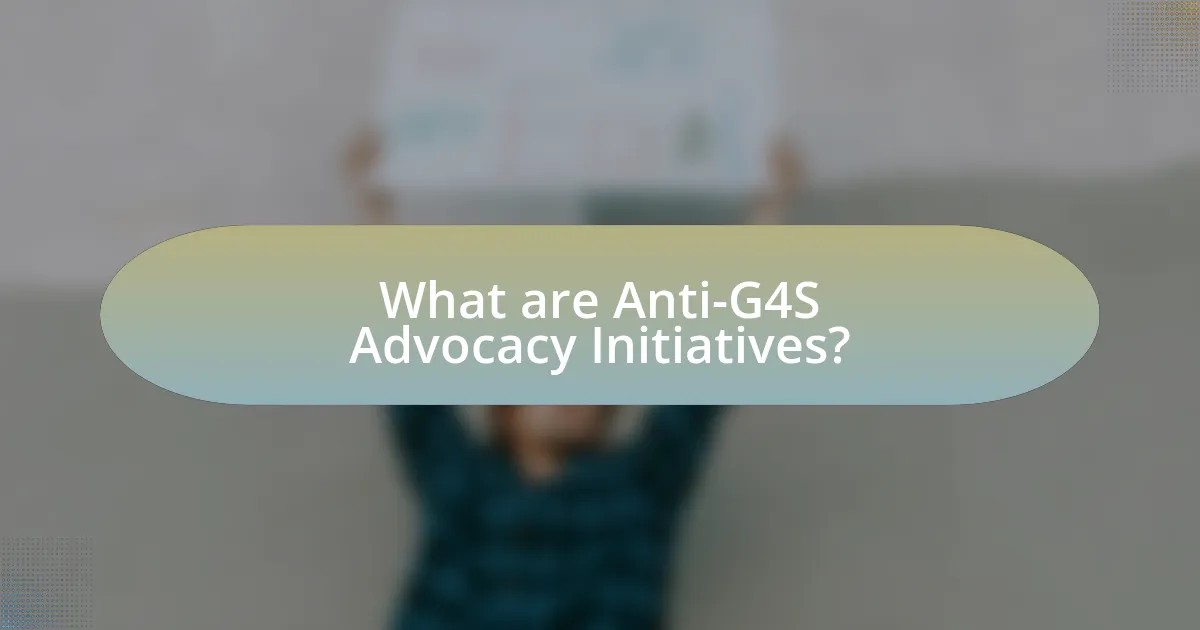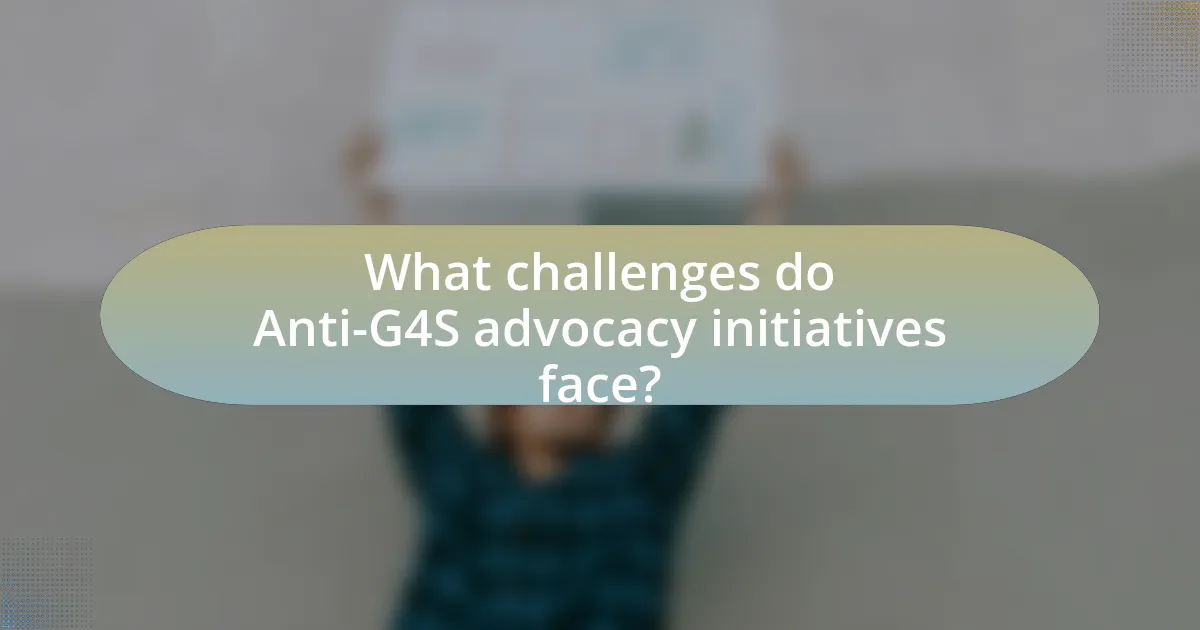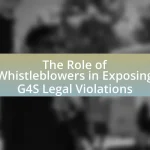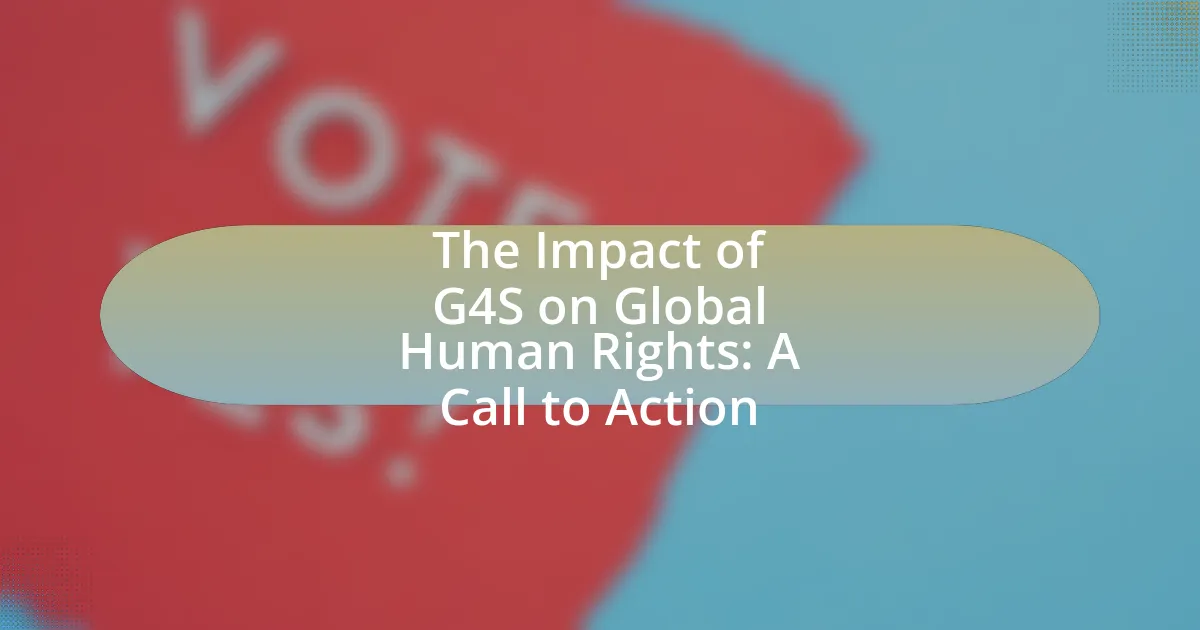Anti-G4S Advocacy Initiatives are organized efforts aimed at opposing the practices of G4S, a global security company criticized for human rights violations. This article examines the significance of these initiatives in promoting corporate accountability, highlighting successful campaigns such as the Boycott, Divestment, Sanctions (BDS) movement and grassroots activism in various countries. It discusses the strategies employed by activists, the challenges they face, and the impact of these initiatives on G4S’s operations, particularly in the UK and South Africa. Additionally, the article outlines best practices for building community support and enhancing outreach in advocacy efforts against G4S.

What are Anti-G4S Advocacy Initiatives?
Anti-G4S Advocacy Initiatives are organized efforts aimed at opposing the operations and practices of G4S, a global security company often criticized for its involvement in human rights violations and unethical practices. These initiatives typically involve grassroots campaigns, public awareness efforts, and strategic partnerships with human rights organizations to highlight G4S’s controversial activities, such as its role in the Israeli-Palestinian conflict and its management of immigration detention centers. For example, campaigns like “Boycott G4S” have gained traction, urging consumers and institutions to divest from G4S, thereby applying economic pressure to effect change.
Why are these initiatives important in the global context?
These initiatives are important in the global context because they address human rights violations and promote corporate accountability on an international scale. Successful anti-G4S advocacy initiatives have highlighted systemic issues related to privatized security and its impact on vulnerable populations, leading to increased awareness and pressure for reform. For instance, campaigns have documented instances of abuse and exploitation linked to G4S operations, prompting responses from governments and international organizations to reassess their partnerships with such corporations. This collective action fosters a global dialogue on ethical business practices and encourages other organizations to adopt similar accountability measures, ultimately contributing to a more just and equitable society worldwide.
What role does G4S play in various sectors?
G4S operates primarily in the security services sector, providing a range of services including manned security, electronic surveillance, and cash management. In the public sector, G4S is involved in prison management and immigration services, managing facilities and providing security personnel. In the retail sector, G4S offers loss prevention and security solutions to protect assets and ensure safety. Additionally, in the events sector, G4S provides crowd management and security services for large gatherings. The company’s global presence and extensive experience enable it to adapt its services to meet the specific needs of various industries, reinforcing its role as a key player in security across multiple sectors.
How do advocacy initiatives challenge G4S’s practices?
Advocacy initiatives challenge G4S’s practices by exposing human rights violations and promoting accountability. For instance, organizations like Amnesty International have documented instances of G4S’s involvement in controversial detention practices and security operations that violate international human rights standards. These initiatives mobilize public opinion and pressure stakeholders, including governments and corporations, to reconsider their contracts and associations with G4S, thereby impacting the company’s operational legitimacy and financial stability.
What are some key characteristics of successful advocacy initiatives?
Successful advocacy initiatives typically exhibit clear goals, strong leadership, effective communication, and community engagement. Clear goals provide direction and measurable outcomes, while strong leadership ensures strategic planning and mobilization of resources. Effective communication fosters awareness and support, often utilizing social media and traditional media to reach broader audiences. Community engagement builds grassroots support, as seen in various successful campaigns where local involvement amplified the message and increased pressure on decision-makers. These characteristics have been validated through numerous case studies, demonstrating that initiatives with these traits are more likely to achieve their objectives and create lasting change.
How do grassroots movements contribute to these initiatives?
Grassroots movements significantly contribute to anti-G4S advocacy initiatives by mobilizing community support and raising awareness about human rights violations associated with G4S operations. These movements often engage local populations, fostering a sense of ownership and empowerment, which leads to increased participation in protests, campaigns, and educational efforts. For instance, grassroots organizations have successfully organized demonstrations that highlight G4S’s involvement in controversial practices, such as detention center management and security contracts with governments accused of human rights abuses. This grassroots activism has been instrumental in pressuring policymakers and corporations to reconsider their associations with G4S, as evidenced by the divestment campaigns led by local groups that have resulted in significant financial losses for the company.
What strategies are commonly employed in successful campaigns?
Successful campaigns commonly employ strategies such as grassroots mobilization, targeted messaging, coalition building, and leveraging social media. Grassroots mobilization involves engaging local communities to create a strong base of support, which has been effective in various advocacy initiatives. Targeted messaging ensures that the campaign resonates with specific audiences, increasing the likelihood of engagement and action. Coalition building brings together diverse groups to amplify the campaign’s reach and impact, as seen in successful anti-G4S initiatives where multiple organizations collaborated for a common goal. Leveraging social media allows campaigns to disseminate information rapidly and engage with a broader audience, facilitating real-time interaction and support. These strategies have been validated by numerous case studies demonstrating their effectiveness in driving change and raising awareness.

What are notable case studies of successful Anti-G4S advocacy initiatives?
Notable case studies of successful Anti-G4S advocacy initiatives include the Boycott, Divestment, Sanctions (BDS) movement, which has effectively pressured institutions to sever ties with G4S due to its involvement in Israeli security operations. For instance, in 2016, the University of California system voted to divest from G4S, citing its role in human rights violations. Additionally, the UK-based organization War on Want successfully campaigned for the closure of G4S contracts with the UK government, highlighting the company’s complicity in the Israeli occupation. These initiatives demonstrate the effectiveness of coordinated advocacy efforts in influencing institutional policies against G4S.
How did the UK-based campaigns impact G4S operations?
UK-based campaigns significantly impacted G4S operations by leading to contract cancellations and reputational damage. For instance, in 2013, the UK government terminated G4S’s contract for providing security services at the London Olympics due to failures in performance and public outcry over the company’s involvement in controversial practices, such as operating detention centers. Additionally, campaigns organized by groups like the Boycott G4S movement raised awareness about human rights violations associated with G4S’s operations in Israel and Palestine, resulting in universities and local councils divesting from the company. These actions collectively pressured G4S to reassess its business practices and focus on improving its public image.
What specific actions were taken by activists in the UK?
Activists in the UK organized protests, campaigns, and public awareness initiatives against G4S, focusing on the company’s involvement in human rights abuses and privatization of public services. For instance, in 2013, activists staged a series of demonstrations outside G4S facilities, highlighting its role in the detention of asylum seekers and its contracts with the UK government. Additionally, groups like the Stop G4S Campaign mobilized support through petitions and social media, successfully pressuring institutions to reconsider their contracts with the company. These actions contributed to increased scrutiny of G4S and its practices, demonstrating the effectiveness of grassroots activism in influencing public policy and corporate accountability.
What outcomes resulted from these campaigns?
The outcomes of the anti-G4S advocacy campaigns included significant reductions in G4S contracts, increased public awareness of human rights violations associated with the company, and the mobilization of grassroots movements against its operations. For instance, campaigns in various countries led to the cancellation of contracts with G4S by several universities and local governments, demonstrating the effectiveness of organized advocacy. Additionally, these initiatives resulted in heightened scrutiny of G4S’s practices, influencing public opinion and prompting discussions on corporate accountability in human rights.
What lessons can be learned from international case studies?
International case studies reveal that effective advocacy against corporations like G4S often hinges on community engagement, strategic partnerships, and leveraging media. For instance, the successful campaign against G4S in South Africa demonstrated that mobilizing local communities and forming coalitions with human rights organizations can amplify voices and create pressure for change. Additionally, the use of social media to raise awareness and disseminate information has proven essential in garnering public support and influencing policy decisions. These examples underscore the importance of a multifaceted approach that combines grassroots activism with broader strategic initiatives to achieve advocacy goals.
How did campaigns in South Africa address local issues with G4S?
Campaigns in South Africa addressed local issues with G4S by highlighting concerns over human rights violations and inadequate labor practices. Activists organized protests and awareness campaigns that focused on G4S’s involvement in controversial security operations, particularly in relation to the treatment of workers and detainees. For instance, the #G4SMustFall campaign specifically targeted the company’s role in the management of prisons, where reports of abuse and neglect were prevalent. These campaigns effectively mobilized public opinion and garnered media attention, leading to increased scrutiny of G4S’s operations in the country.
What unique approaches were taken in the US against G4S?
Unique approaches taken in the US against G4S included grassroots organizing, public awareness campaigns, and legal challenges. Grassroots organizing involved coalitions of community groups and labor unions mobilizing protests and demonstrations to highlight G4S’s controversial practices, such as its role in immigration detention and prison privatization. Public awareness campaigns utilized social media and traditional media outlets to inform the public about G4S’s operations and their implications for civil rights. Legal challenges were initiated by advocacy groups to hold G4S accountable for alleged human rights violations, resulting in lawsuits that sought to expose and rectify unethical practices. These strategies collectively aimed to disrupt G4S’s operations and promote accountability in the security industry.

What challenges do Anti-G4S advocacy initiatives face?
Anti-G4S advocacy initiatives face significant challenges, including limited public awareness and the company’s extensive resources for counter-campaigning. The lack of widespread understanding about G4S’s operations, particularly in controversial areas such as security in conflict zones, hampers advocacy efforts. Additionally, G4S’s financial power allows it to engage in aggressive public relations strategies, which can undermine the credibility of advocacy groups. For instance, G4S has been involved in various legal and lobbying efforts to protect its interests, making it difficult for advocacy initiatives to gain traction. These factors collectively create a challenging environment for those opposing G4S’s practices.
How do legal and political obstacles affect these initiatives?
Legal and political obstacles significantly hinder anti-G4S advocacy initiatives by creating barriers to effective action and limiting the ability to mobilize support. For instance, restrictive laws on protests and public gatherings can prevent activists from organizing demonstrations, while political opposition may lead to a lack of governmental support for their causes. In many countries, legal frameworks may also protect corporations like G4S from accountability, making it difficult for advocacy groups to challenge their practices. A notable example is the UK, where legal challenges against G4S have often been met with procedural delays and dismissals, illustrating how the legal system can be manipulated to favor corporate interests over public advocacy.
What are common legal challenges faced by activists?
Activists commonly face legal challenges such as arrests, harassment, and restrictions on freedom of assembly. These challenges often arise during protests or advocacy efforts, where law enforcement may impose legal penalties for perceived violations of laws or regulations. For instance, in many countries, activists have been arrested under laws that criminalize dissent or public assembly, which can lead to significant legal battles and the need for legal representation. Additionally, activists may encounter civil lawsuits aimed at silencing their efforts, as seen in various cases where corporations or governments seek to intimidate individuals through legal action.
How do political climates influence advocacy efforts?
Political climates significantly influence advocacy efforts by shaping the legal, social, and economic environments in which advocacy groups operate. For instance, in democratic societies, advocacy efforts often thrive due to the presence of free speech protections and active civil society engagement, as seen in countries like Canada, where advocacy against corporations like G4S has led to policy changes. Conversely, in authoritarian regimes, such as in some Middle Eastern countries, advocacy efforts face severe restrictions, limiting the ability of groups to mobilize and campaign effectively. This dynamic is evidenced by the varying success rates of anti-G4S initiatives, where supportive political climates have facilitated public awareness campaigns and legislative advocacy, while hostile environments have stifled dissent and reduced visibility for such efforts.
What strategies can overcome these challenges?
Strategies to overcome challenges in anti-G4S advocacy initiatives include coalition building, public awareness campaigns, and leveraging legal frameworks. Coalition building allows diverse groups to unite, amplifying their voices and resources, as seen in the collaboration between various human rights organizations that successfully pressured G4S to withdraw from certain contracts. Public awareness campaigns, such as social media initiatives and community outreach, effectively inform the public about G4S’s controversial practices, leading to increased scrutiny and public pressure. Additionally, leveraging legal frameworks, including human rights laws and regulations, can provide a basis for challenging G4S’s operations, as demonstrated in cases where legal action has led to contract cancellations or policy changes. These strategies collectively enhance the effectiveness of advocacy efforts against G4S.
How can coalitions enhance the effectiveness of advocacy initiatives?
Coalitions enhance the effectiveness of advocacy initiatives by pooling resources, expertise, and networks to amplify their collective voice and impact. By collaborating, diverse organizations can share knowledge and strategies, which increases the reach and credibility of their campaigns. For instance, the coalition of various human rights organizations against G4S has successfully mobilized public opinion and influenced policy changes by presenting a united front, demonstrating that coordinated efforts can lead to significant outcomes in advocacy.
What role does public awareness play in overcoming obstacles?
Public awareness is crucial in overcoming obstacles as it mobilizes community support and drives change. When the public is informed about issues, such as the practices of companies like G4S, it fosters collective action and advocacy, leading to pressure on decision-makers. For instance, campaigns that raised awareness about G4S’s involvement in controversial activities resulted in significant public backlash, influencing organizations to reconsider their contracts with the company. This demonstrates that informed citizens can effectively challenge and dismantle systemic barriers through organized efforts and advocacy.
What practical tips can activists use to enhance their initiatives?
Activists can enhance their initiatives by employing strategic communication, building coalitions, and utilizing data-driven approaches. Strategic communication involves crafting clear, compelling messages that resonate with target audiences, which can increase engagement and support. Building coalitions with other organizations amplifies resources and reach, as seen in successful campaigns where diverse groups unite for a common cause. Utilizing data-driven approaches, such as gathering and analyzing statistics on the impact of G4S operations, provides credible evidence that strengthens arguments and persuades stakeholders. For instance, the use of documented human rights violations linked to G4S has been pivotal in mobilizing public opinion and influencing policy changes.
How can effective communication strategies improve outreach?
Effective communication strategies can significantly enhance outreach by ensuring that messages are clear, targeted, and resonate with the intended audience. When advocacy initiatives employ tailored messaging, they can engage stakeholders more effectively, leading to increased awareness and support. For instance, research by the Pew Research Center indicates that 70% of individuals are more likely to engage with content that is personalized and relevant to their interests. This demonstrates that effective communication not only captures attention but also fosters a deeper connection with the audience, ultimately driving action and participation in advocacy efforts.
What are best practices for building community support?
Best practices for building community support include fostering open communication, engaging stakeholders, and creating inclusive spaces for dialogue. Open communication ensures that community members feel heard and valued, which builds trust and encourages participation. Engaging stakeholders, such as local leaders and organizations, helps to mobilize resources and amplify voices within the community. Creating inclusive spaces for dialogue allows diverse perspectives to be shared, fostering a sense of belonging and collective action. These practices have been shown to enhance community cohesion and effectiveness in advocacy efforts, as evidenced by successful initiatives that prioritize community involvement and collaboration.





